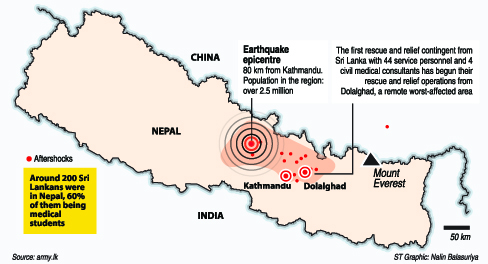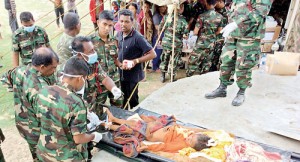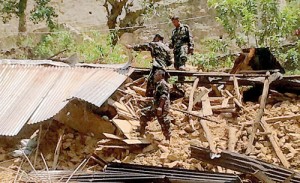News
Lanka responds promptly in Nepal’s hour of need
The response was instantaneous – as soon as news of Nepal’s earthquake-devastation was received, out-flew not only Army personnel from Sri Lanka but also four civilian doctors to help in search-and-rescue operations as well as to treat numerous victims.
The 44-member Army contingent headed by Major General Maithri Dias and the civilian doctors who left Sri Lanka on the C130 Air Force flight landed early the next morning and were assigned by the Nepali government to Dolalghat, about 60km northeast of the capital of Kathmandu, which they accessed by road, said Acting Military Spokesman, Brigadier Jayanath Jayaweera, who is also Director of Army Media.
The earthquake had caused much destruction to the roads too, he said, adding that the area assigned to them is isolated and hilly.
On arrival there, they set up a field hospital and set to work, treating casualties and deploying teams for rescue operations in adjacent areas, it is learnt.
“They worked while aftershocks were still being felt in the area and amidst much hardship common after a natural disaster such as the lack of electricity and water,” said Brigadier Jayaweera.
Not content to watch while Nepal suffered amidst the throes of this natural disaster, a larger joint armed forces contingent of 97 also left on Wednesday on a SriLankan Airlines flight headed for Kathmandu along with 15 tons of dry rations, water, medical supplies and also engineering equipment, the Sunday Times learns.

Sri Lankan Army personnel treat victims and involved in search operations
The second support group comprises 72 Army personnel including three officers, 14 Navy personnel including one officer and 11 Air Force personnel including one officer, said Brigadier Jayaweera, adding that they are augmenting those at Dolosghat, to expand search-and-rescue operations, while also treating more casualties.When contacted, Dr. Sugandhika Perera, Acting National Coordinator of the Health Ministry’s Disaster Preparedness and Response Unit, said that the four doctors who left on the first mission comprised three surgeons and an anaesthetist. They also took with them four tons of medical supplies.
They are dealing with casualties being brought to the outreach field hospital, she said, adding that another team of 40 healthcare personnel are ready to leave at a moment’s notice.
Meanwhile, e-mail contact between the Human Genetics Unit (HGU) of the Colombo Medical Faculty and the National Academy of Medical Sciences (NAMS), Nepal (similar to the Post-graduate Institute of Medicine in Sri Lanka), creates tragic images of the situation there and what the country needs urgently.
When Prof. Vajira H.W. Dissanayake, Director of the HGU — which has been helping Nepal since 2010 to develop its medical genetic services – contacted NAMS Vice Chancellor Dr. Ganesh Gurung, offering support in the aftermath of the earthquake, this is the image that the latter painted.
 With NAMS running the main Bir Hospital in Kathmandu, Dr. Gurung has said that severely injured victims are being brought to the Trauma Centre and the hospital is in “dire need” of logistical support. More than 150 patients are in the queue for operations, a majority of whom have limb, head, chest or abdominal injuries.
With NAMS running the main Bir Hospital in Kathmandu, Dr. Gurung has said that severely injured victims are being brought to the Trauma Centre and the hospital is in “dire need” of logistical support. More than 150 patients are in the queue for operations, a majority of whom have limb, head, chest or abdominal injuries.
According to Prof. Dissanayake, Dr. Gurung has made a request for urgent supplies such as disposable sterile gowns and caps and masks; disposable draping sets; disposable dressing sets; disposable CVP sets; disposable C-arm covers; antiseptic solution; IV fluids; IV sets; IV cannulae 16-21G; infusion pumps; fluid warmers; blood warmers; volume expanders; syringe pumps; suction catheters; pajamas, shirts and blankets for patients; and the list goes on.
Working round-the-clock at the Trauma Centre, Dr. Gurung has explained the tragedy thus: Altogether around 90 people were brought in dead and nine died after arrival. More than 250 injured victims were brought to the Trauma Centre. The death toll in the TU Teaching Hospital, Patan Hospital and private hospitals are to be recorded. We do not know the exact situation at other hospitals.
“Victims from outside Kathmandu valley are being brought to the Trauma Centre now, so how many people might have been affected is difficult to calculate. At the epicentre of the earthquake such as Gorakha and Lamjung more than 95 houses have collapsed, millions of people are homeless and thousands are injured. The most affected are the remote places, where rescue groups have not been able to reach,” he adds.

